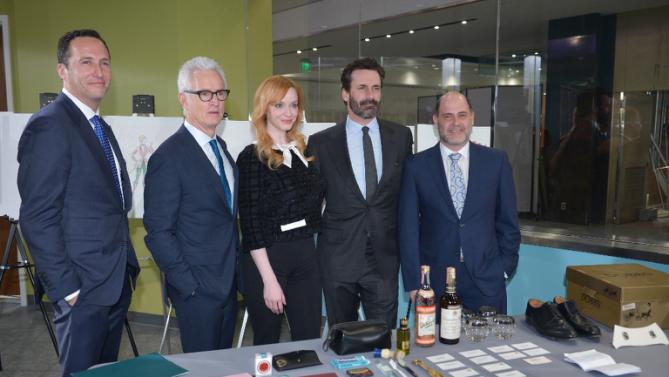Its depiction of 1960s cool has become such a part of US culture that props from the show were donated to the Smithsonian's National Museum of American History on Friday.
In the final episodes -- the second half of season seven -- viewers will learn the fate of the seductive and mysterious Don Draper (Jon Hamm), a gifted and charismatic ad man who has built his adult life on a falsehood.
Without giving away key plot points, Hamm said Draper "has attempted to build several houses on very broken foundations, and needs to address those foundations before he starts building a new house."
"Maybe he finds out in the next seven episodes his commitment to fixing what can be fixed," Hamm told a press conference in Los Angeles ahead of the April 5 premiere on US television.
When it was launched, "Mad Men" offered something new in an American television landscape dominated by crime procedurals and action/mystery programs like "24," "Lost" or "Dexter."
The pilot episode written by series creator Matthew Weiner was actually rejected by pay-TV channels HBO and Showtime before being taken up by AMC, which at the time was known more for re-running classic films.
While anti-heroes have become nearly the norm on critically acclaimed programs (mafia boss Tony Soprano and teacher-turned-drug-dealer Walter White in "Breaking Bad" come to mind), nearly all of the main characters on "Mad Men" are riddled with faults.
Everyone -- even Draper's long-suffering and courageous protegee Peggy Olson (played by Elisabeth Moss) -- commits morally questionable acts, whether it be adultery, betrayal, lies or abandonment.
- Kennedy-era glamour -
"The show didn't shy away from the basic human condition," said Vincent Kartheiser, who plays Pete Campbell, a young ad man from a wealthy family battling for the respect of his peers and affections of his female companions.
"Mad Men" also won over critics with its big screen-worthy cinematography.
"There was a glamour assigned to the sixties in America -- it was the Jackie Kennedy era," said John Slattery, who plays impetuous and self-centered dandy Roger Sterling.
The show helped revive 1960s fashion and sparked a spate of "Mad Men" parties, with women in retro dresses and glamorous up-hairdos, and men in tight-fitting suits, hats and polished shoes.
The series also depicted an era ruled by casual racism, sexism, alcoholism and tobacco addiction, and where child discipline sometimes verged on abuse.
But as several of the actors noted, while today's society may be more open, time hasn't necessarily cured all its ills.
There is a scene in the final season where Peggy and Joan (Christina Hendricks) try to sell an ad idea to three potential clients who make repeated degrading comments about Joan's ample bosom.
"I can absolutely relate to that," said Hendricks, adding: "I've been in rooms when sexual innuendo has been made when I'm talking about my work."
When asked what the present-day versions of her character would be, Hendricks said Joan, an ambitious and feminist single mother, "would be pretty much the same."
Pete Campbell would be forced to keep some of his comments to himself, but would "still be a douchebag," said Kartheiser.
And Don Draper, could he exist in 2015?
"God no!" said Hamm.
------------------------------------------------------------------------------------------------------------
In the final episodes -- the second half of season seven -- viewers will learn the fate of the seductive and mysterious Don Draper (Jon Hamm), a gifted and charismatic ad man who has built his adult life on a falsehood.
Without giving away key plot points, Hamm said Draper "has attempted to build several houses on very broken foundations, and needs to address those foundations before he starts building a new house."
"Maybe he finds out in the next seven episodes his commitment to fixing what can be fixed," Hamm told a press conference in Los Angeles ahead of the April 5 premiere on US television.
When it was launched, "Mad Men" offered something new in an American television landscape dominated by crime procedurals and action/mystery programs like "24," "Lost" or "Dexter."
The pilot episode written by series creator Matthew Weiner was actually rejected by pay-TV channels HBO and Showtime before being taken up by AMC, which at the time was known more for re-running classic films.
While anti-heroes have become nearly the norm on critically acclaimed programs (mafia boss Tony Soprano and teacher-turned-drug-dealer Walter White in "Breaking Bad" come to mind), nearly all of the main characters on "Mad Men" are riddled with faults.
Everyone -- even Draper's long-suffering and courageous protegee Peggy Olson (played by Elisabeth Moss) -- commits morally questionable acts, whether it be adultery, betrayal, lies or abandonment.
- Kennedy-era glamour -
"The show didn't shy away from the basic human condition," said Vincent Kartheiser, who plays Pete Campbell, a young ad man from a wealthy family battling for the respect of his peers and affections of his female companions.
"Mad Men" also won over critics with its big screen-worthy cinematography.
"There was a glamour assigned to the sixties in America -- it was the Jackie Kennedy era," said John Slattery, who plays impetuous and self-centered dandy Roger Sterling.
The show helped revive 1960s fashion and sparked a spate of "Mad Men" parties, with women in retro dresses and glamorous up-hairdos, and men in tight-fitting suits, hats and polished shoes.
The series also depicted an era ruled by casual racism, sexism, alcoholism and tobacco addiction, and where child discipline sometimes verged on abuse.
But as several of the actors noted, while today's society may be more open, time hasn't necessarily cured all its ills.
There is a scene in the final season where Peggy and Joan (Christina Hendricks) try to sell an ad idea to three potential clients who make repeated degrading comments about Joan's ample bosom.
"I can absolutely relate to that," said Hendricks, adding: "I've been in rooms when sexual innuendo has been made when I'm talking about my work."
When asked what the present-day versions of her character would be, Hendricks said Joan, an ambitious and feminist single mother, "would be pretty much the same."
Pete Campbell would be forced to keep some of his comments to himself, but would "still be a douchebag," said Kartheiser.
And Don Draper, could he exist in 2015?
"God no!" said Hamm.
------------------------------------------------------------------------------------------------------------









 Home
Home Politics
Politics











